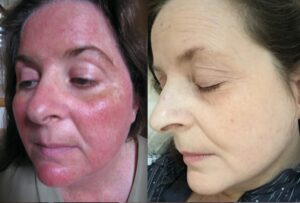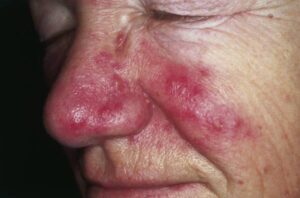Rosacea: Skin Care, Treatment, and Living with Rosacea
Rosacea is a common skin condition that affects millions of people worldwide, often leading to both physical discomfort and emotional distress. At Cameo College, we aim to equip our students with the knowledge needed to understand this inflammatory skin condition fully. As future skincare professionals, understanding rosacea from its symptoms to treatment options is paramount. While rosacea may not be curable, effective management of rosacea can significantly improve the quality of life for those affected. Through this article, we explore the essentials of rosacea, diving into its definition, symptoms, and types.
What is Rosacea?

“Steroid Rosacea” by Corinna Kennedy is licensed under CC BY-SA 4.0
Definition and Overview
Rosacea is a chronic inflammatory skin condition characterized by facial redness and visible blood vessels. It is a common skin condition that primarily affects the face, often mistaken for acne or other skin disorders. However, unlike acne, rosacea does not involve clogged pores. The condition can be persistent, with periods of flare-ups and remission. Factors that cause rosacea vary, including environmental and genetic components. While the exact cause remains unknown, it is crucial for future estheticians to recognize the signs and understand the treatment of rosacea to offer better care and advice to clients seeking relief.
Symptoms of Rosacea
The symptoms of rosacea can vary significantly among individuals. Understanding these symptoms is vital for those studying at Cameo College, as recognizing the signs can aid in the appropriate referral to a dermatologist for a diagnosis and treatment plan, ensuring a comprehensive approach to skin care. Typically, rosacea symptoms include:
- Persistent facial redness
- Swollen red bumps
- Visible blood vessels
- Skin sensitivity, burning or stinging sensations, and dry skin
- Ocular rosacea, which involves irritation and redness of the eyes
Types of Rosacea

“Rosacea” by Michael Sand, Daniel Sand, Christina Thrandorf, Volker Paech, Peter Altmeyer, Falk G Bechara is licensed under CC BY 2.5
Rosacea can manifest in several forms, each presenting distinct characteristics. Understanding these variations is crucial for future skincare professionals, as it aids in tailoring a customized skin care routine and treatment plan for patients with rosacea, ensuring effective management and relief.
| Type of Rosacea | Characteristics |
|---|---|
| Erythematotelangiectatic Rosacea | Characterized by facial redness and visible blood vessels |
| Papulopustular Rosacea | Marked by redness, swelling, and acne-like breakouts |
| Phymatous Rosacea | Thickens the skin, often on the nose |
| Ocular Rosacea | Affects the eyes |
Each type may require different treatment options, such as topical treatment or laser treatment.
Diagnosis and Consultation
When to See a Dermatologist
For individuals experiencing persistent rosacea symptoms such as facial redness, visible blood vessels, or acne-like breakouts, consulting a dermatologist is essential. At Cameo College, we emphasize the importance of recognizing when professional assessment is necessary to manage rosacea effectively. A dermatologist can provide a comprehensive evaluation to distinguish rosacea from other common skin conditions, such as acne or skin cancer. Early diagnosis and treatment of rosacea are crucial in preventing progression and reducing the frequency of rosacea flare-ups. Timely intervention can help patients with rosacea achieve better management of their symptoms and improve their overall quality of life.
Diagnostic Procedures
The diagnostic process for rosacea typically involves a thorough examination of the skin by a dermatologist. They may inquire about the patient’s medical history, including any family history of rosacea or other inflammatory skin conditions. In some cases, a skin biopsy might be performed to rule out other skin disorders. While there are no specific tests for rosacea, a dermatologist’s expertise is crucial in identifying the condition accurately. Understanding these diagnostic procedures is vital for students at Cameo College, as it prepares them to guide clients in seeking appropriate medical advice and developing an effective treatment plan tailored to their unique needs.
Understanding Your Diagnosis
Once a diagnosis of rosacea is confirmed, it is important for patients to understand the implications and management strategies. At Cameo College, we educate our students on how to assist clients in navigating their diagnosis. This includes discussing potential treatment options, such as topical treatments, laser treatments, and lifestyle modifications, to manage rosacea symptoms effectively. Patients with rosacea are encouraged to use skin care products designed for sensitive skin to prevent irritation. By understanding their diagnosis, clients can work collaboratively with their dermatologists to develop a personalized treatment plan that addresses their specific concerns and promotes healthier, rosacea-prone skin.
Treatment for Rosacea

Photo by Nataliya Melnychuk on Unsplash
Topical Treatments
Topical treatments are a cornerstone in the management of rosacea, providing targeted relief for many patients with this inflammatory skin condition. These treatments often include creams and gels formulated to reduce inflammation, redness, and other rosacea symptoms. Common topical medications prescribed by dermatologists aim to treat rosacea by decreasing the number and severity of rosacea flare-ups. For individuals with mild to moderate rosacea, these topical treatments can be particularly effective. At Cameo College, we educate our students about the importance of selecting appropriate skin care products and maintaining a consistent skin care routine. Key aspects of this education include:
- Selecting skin care products that cater to sensitive skin.
- Understanding the significance of a consistent skin care routine.
Oral Medications
In cases where topical treatments are insufficient, oral medications may be recommended as part of the treatment plan for rosacea. These medications are typically prescribed to manage more persistent symptoms, such as those seen in papulopustular rosacea, characterized by acne-like breakouts. Oral antibiotics can help reduce inflammation and bacteria, while other medications may target specific triggers that cause rosacea flare-ups. Understanding the role of oral medications in the treatment of rosacea is crucial for our students, as they learn to guide clients in seeking appropriate medical advice and exploring options for rosacea management under the supervision of a dermatologist.
Alternative Therapies
Beyond standard management options for rosacea, alternative therapies can offer additional relief for individuals seeking holistic approaches. These may include lifestyle changes, dietary adjustments, and stress management techniques aimed at minimizing rosacea triggers. Laser treatment is another option that can effectively reduce redness and visible blood vessels, providing long-term improvement for some people with rosacea. While alternative therapies may appeal to those looking for non-medical interventions, it is essential for students at Cameo College to advise clients on the importance of consulting with a dermatologist or healthcare professional to ensure safe and effective treatment for rosacea and to avoid exacerbating symptoms.
Managing Rosacea Flare-Ups

Photo by Wil Stewart on Unsplash
Common Triggers of Rosacea
Understanding the common triggers of rosacea is crucial for effective management of this inflammatory skin condition. Various factors can cause rosacea flare-ups, including exposure to sunlight, extreme temperatures, stress, and certain foods or beverages like spicy dishes and alcohol. At Cameo College, we emphasize educating our students on identifying these triggers to help clients minimize their exposure and reduce the frequency of flare-ups. Recognizing individual triggers allows patients with rosacea to tailor their lifestyle and skin care routine, ensuring a proactive approach to managing rosacea symptoms.
Effective Skin Care Tips
Implementing effective skin care tips is essential in the management of rosacea. People with rosacea often have sensitive skin, making it important to choose skin care products specifically designed for their needs. Gentle cleansers, moisturizers, and sunscreens that do not irritate the skin are recommended. At Cameo College, we teach our students about the significance of using products free of alcohol, fragrances, and other potential irritants. Consistent use of a mild cream or topical treatment can help soothe dry skin and reduce redness, improving the overall appearance and comfort of rosacea-prone skin.
Creating a Personal Care Routine
Creating a personal care routine tailored to individual needs is vital for those living with rosacea. Understanding the importance of a structured skin care routine helps in managing this common skin condition effectively. Patients with rosacea should incorporate gentle skin care tips and treatment options recommended by a dermatologist into their daily regimen. This may include the application of prescribed creams or topical treatments to manage rosacea symptoms. At Cameo College, we guide our students to support clients in establishing a personalized care routine that aligns with their specific rosacea treatment plan, enhancing their journey to healthier skin.
Living with Rosacea

Photo by Tim Marshall on Unsplash
Emotional and Social Impacts
Living with rosacea can have significant emotional and social impacts, affecting self-esteem and confidence. The visible symptoms of rosacea, such as redness and acne-like breakouts, may lead to feelings of self-consciousness and embarrassment. At Cameo College, we aim to prepare our students to provide empathetic support and understanding to individuals dealing with these challenges. By fostering a compassionate environment, future skincare professionals can help clients navigate the emotional aspects of living with rosacea, promoting a positive outlook and encouraging them to seek effective management of rosacea symptoms.
Support and Resources
Access to support and resources plays a crucial role in managing rosacea. Organizations like the National Rosacea Society offer valuable information and guidance for individuals seeking to understand rosacea better. At Cameo College, we educate our students about the importance of connecting clients with these resources, which can provide insights into treatment options and coping strategies. Support groups and online communities also offer a platform for sharing experiences and advice, fostering a sense of solidarity among people with rosacea. Encouraging clients to utilize these resources can empower them to take control of their rosacea journey.
Encouraging Acceptance and Awareness
Encouraging acceptance and raising awareness about rosacea are vital components in supporting individuals living with this common skin condition. At Cameo College, we emphasize the importance of educating future skincare professionals to promote understanding and reduce stigma associated with rosacea. By fostering an inclusive environment, we can help clients accept their condition and focus on effective management strategies. Awareness campaigns and educational initiatives can also play a role in highlighting the realities of living with rosacea, encouraging broader societal understanding and empathy, ultimately contributing to a more supportive community for those affected.

